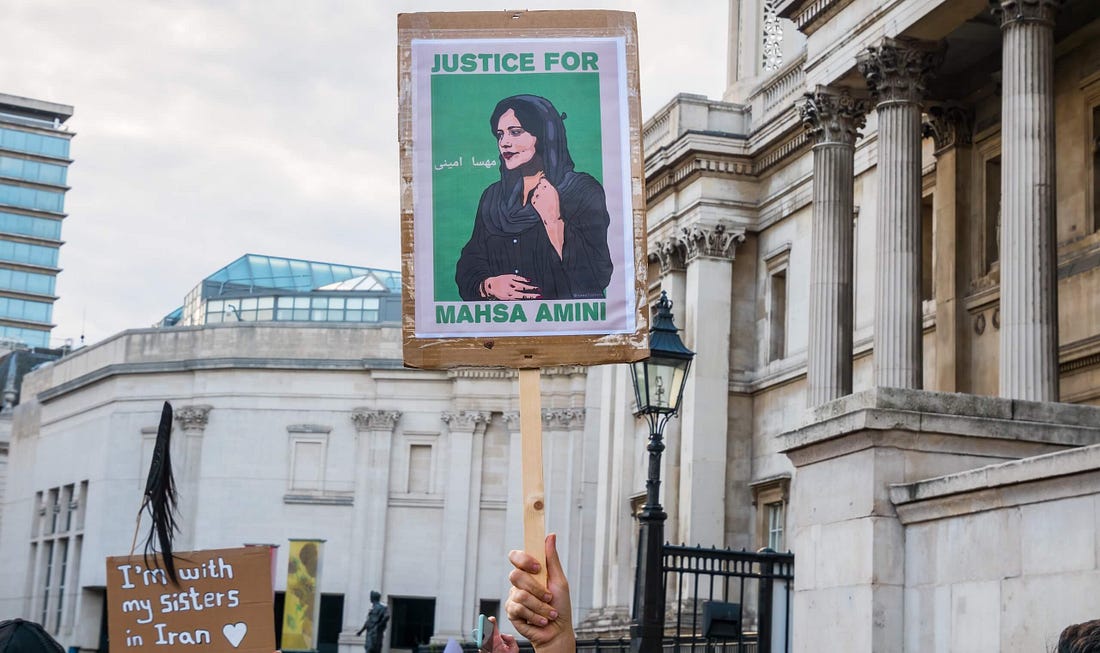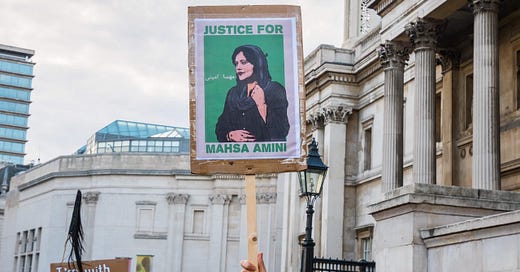
It’s been nearly three weeks since Mahsa Amini was murdered by Iran’s “morality” police for the supposed crime of improperly wearing her hijab, but protests throughout Iran, and the world, continue. From Tehran to London to Los Angeles, women burn their hijabs and cut their hair while crowds chant “women—life—liberty,” “death to the headscarf,” and “death to the dictator—death to Khamenei.”
The twenty-two-year-old was not the first victim to die at the hands of Iranian police. After protests in 2003, Iranian-Canadian journalist Zahra Kazemi was arrested while photographing families waiting for news of their loved ones outside Iran’s notorious Evin Prison. She showed officers her government-issued press pass but was taken into Evin anyway, where she was tortured. Her captors ripped out her fingernails, flogged her, raped her, and cracked her skull. Just as Iranian officials now are claiming that Amini died of a heart attack, they claimed then that Kazemi died of a stroke, later changing their account to say that she fell and hit her head. When the gory truth was revealed by Kazemi’s medical examiner almost two years later, it sparked international furor.1
Like Kazemi (and Sattar Beheshti, tortured and killed for publishing a blog post claiming that Iran is “nothing but a slaughterhouse”), Amini has become a symbol—even a saint, not of any religion, but of a movement for freedom from religiously motivated oppression.2 Unsurprisingly, the oppressors are responding in line with their bloody track record. According to reports, more than 150 protestors have been killed so far, and at least forty journalists have been jailed.3
Ayatollah Ali Khamenei often dismisses Western outrage over his regime’s atrocities, saying, for instance, “The ridiculous accusations such as human rights violations or seeking weapons of mass destruction, are only empty claims aimed at exerting pressure on the Islamic Republic.”4 In his view, the United States seeks to overturn the Islamic theocracy via the subtle art of “postmodern colonialism”—that is, “through propaganda tactics and colorful enticements.”5 When an American commentator said, “Instead of bombs, send them miniskirts,” the ayatollah responded, “He is right,” explaining, “More than Iran’s enemies need artillery, guns and so forth, they need to spread cultural values that lead to moral corruption.”6
As subversive to Islam as air-dropping miniskirts might be, the Western export most responsible for undermining tyrannical government is not sex appeal but science and technology, and the thing that makes these possible: reason. Khamenei’s predicament stems from Iranians’ growing respect for and proficiency in these fields, which the ayatollah himself praises and promotes within the context of his quest to make Iran a nuclear powerhouse.
Khamenei’s “ideal vision,” writes Karim Sajdadpour, an Iranian American policy analyst at the Carnegie Endowment, “is of an Iran that is scientifically and technologically advanced enough to be self-sufficient, self-sufficient enough to be economically independent, and economically independent enough to be politically independent.”7 Khamenei recognizes that Iran’s “most talented students have always studied at our technical colleges.”8 But what he misses is that scientifically advanced, increasingly affluent, independent thinkers will, however gradually, come to desire a government in line with these values. In his recent book What Went Right?, Robert Tracinski explains the underlying phenomenon, describing how ideas spread implicitly via cultural institutions:
If people who have been trained in a scientific education then encounter the basic tenets of a pro-reason philosophy, they will regard them as practically self-evident. Although those principles are not at all self-evident, they will feel as if they were, because the broad philosophic truths are implicit in so many of the truths that the individual has grasped in his studies of mathematics, geometry, physics, engineering, medicine, and so on.9
More and more Iranians are pursuing careers in science—which is all about the nature of things and the law of cause and effect. They rely on the evidence of their senses, and they reason logically and mathematically. Some may become experts in compartmentalizing the methods of reason. They may not adhere to them outside their specialties, for instance, when considering religious beliefs or social conditions. But, in time, more and more will. They will find it increasingly difficult to meet the strict demands of science when splitting atoms or performing surgery—while simultaneously ignoring the absurdities inherent in the idea that Khamenei is God’s voice on Earth, or that Muhammed rode a winged horse to heaven and back. In other words, they will experience, firsthand, the age-old conflict between reason and faith.
Khamenei may not see the clash, but clerics of centuries past certainly did. During the Islamic Golden Age (ca. 700–1200 AD), Muslims drank deeply from the wells of Greek and Roman knowledge. Persians and Arabs built on Western achievements, reaching new heights in medicine, mathematics, and literature. But almost inevitably, this respect for reason led to laxity in faith. Al-Razi (ca. 850–925)—a Persian physician whose twenty-volume Kitab al-Hawi (Comprehensive Book) was, for a time, the world’s preeminent medical textbook—came to forthrightly reject Islam, and religion more generally. “Religions,” he wrote, have “been resolutely hostile to philosophical speculation and scientific research. The so-called holy scriptures are worthless and have done more harm than good.” He even characterized Muslim prophets as “nothing but billy goats with long beards.” Likewise, the Arab poet Al-Maʿarrī (973–1058) wrote:
Some hope that an Imam with prophet’s gaze
Will rise and all the silent ranks amaze.
Oh, idle thought! There’s no Imam but Reason
To point the morning and the evening ways . . .
Shall we in these old tales discover truth,
Or are they worthless fables told to youth?10
As scientifically fueled hostility to religion grew, so did the religious backlash. Islamic clerics, intent on retaining power, eventually reverted to the belief best stated by the ultraorthodox scholar Ahmad ibn Hanbal (780–855): “Every discussion about a thing which the Prophet did not discuss is an error.”11 Books were burned, scientists repudiated and banished, or worse. Reason, the foreign invader, was recognized as antithetical to Islam and cast out. The Islamic world returned to a dark age in which it has largely remained.
Respect for reason is one of those “cultural values that lead to moral corruption”—if one accepts Muhammed’s conception of morality. But why do so? Every honest, thinking Iranian knows there is nothing just or ethical about a system that slays a twenty-two-year-old girl for the “crime” of letting a lock of hair escape her hijab. What they desperately need to learn (as do many in the West) is that choosing reason and freedom, although antithetical to religion, is essential to morality. True morality stems from the same root as all other truths—not faith or revelation, but reason. It recognizes man’s rational faculty as his only means of knowledge and basic means of survival, and it upholds the individual’s right to life, demanding that each and every person be free to act on his own judgment in pursuit of his own happiness, so long as he doesn’t violate the equal rights of others.
Inklings of such ideas ride in upon the one Trojan horse Khamenei somehow has failed to suspect: rational study and achievement in science and technology. He has said that an Islamic revival is spreading through the Middle East, not by conscious intent, but by its own accord, “like the scent of spring flowers that is carried by the breeze.”12 Maybe so, but a headwind is blowing steadily and insistently from the West. The slaughter of Amini has brought this fundamental alternative back to the fore in Iran: faith, force, and the vast desert of ignorance that has so long swallowed the potential of the Persian people—or reason, freedom, and, perhaps, a second golden age in the Middle East. Iranians know what we “postmodern colonialists” will be rooting for. Let us hope, for the sake of modernity, civilization, and the Iranian people, that they won’t let their mullahs make the same mistake again.



